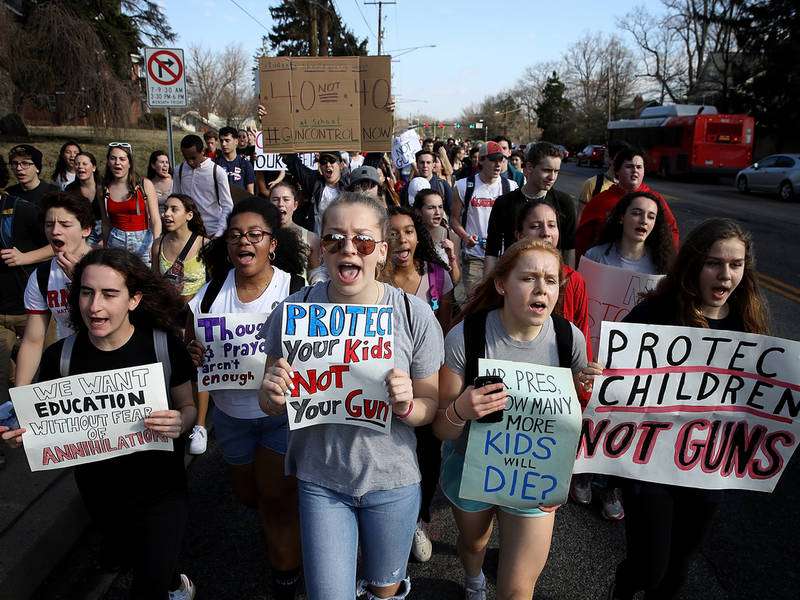Enough: A Generation Standing Against Gun Violence
Guns have become synonymous with the United States in the same way as apple pie and baseball. The Second Amendment of the United States Constitution has protected the right of individuals to keep and bear arms since its adoption in 1971, making guns an integral part of American culture. In fact, as of 2017, Americans own nearly half (48%) of the total 650 million civilian-owned guns worldwide. They own an approximate 89 guns per 100 residents, which means Americans own more guns per capita than any other country. Even more shocking, with a population representing only 5% or the global population, the United States accounts for 31% of global mass shootings. Clearly there is a problem.
Gun laws have grown to be one of the most divisive topics in American politics. The political spectrum is split between those who support gun rights, often Republican, and those who support gun control, often Democrats. While it has been the topic of much debate, very little has been done to change the laws that support such disproportionate gun violence and gun possession. There has been a cyclic process of mass shooting, debate, and no tangible government action. With this failure of change, an unlikely demographic has taken a strong stance to end gun violence once and for all. In response to the Stone Douglas High School Shooting in Parkland, Florida, which took the lives of 17 and wounded others, students across America have sent a clear message: enough is enough. On Wednesday, 14 March, thousands of students took part in a 17 minute walk out; each minute was for one of the lives recently lost. The event was equally a way to pay tribute and a protest against the gun violence on which they were raised. They demand governmental action before another school shooting deprives them of a safe learning environment.
Joe Biden, the former Vice President of the United States once said, “No fundamental social change occurs merely because government acts. It’s because civil society, the conscience of a country begins to rise up and [demand] change.” It may be that this new-found energy led by the country’s youth is the demand required for the occurrence of fundamental social change.
The National Student Walkout’s three demands to Congress are simple: ban assault weapons, require universal background checks prior to gun sales, and pass a gun violence order law that would allow courts to disarm people who display warning signs of violent behaviour. In Florida, the Parkland survivors have yet to see these demands take hold; however, Gov. Rick Scott has signed Senate Bill 7026. While this bill does tighten some aspects of gun control, such as raising the minimum age of purchase from 18 to 21, it also allows for teachers to be armed on school grounds. This has brought concern from demonstrators as introducing more guns to a problem of prolific guns will likely exacerbate the problem further. Keno Walker, a walkout organizer in Miami, made clear that “[they] are standing in solidarity with the youth from the mass shooting, but [they] also know the repercussions of what’s going to happen next could fall on the black and brown people.” He is echoing the common concern from the demonstrators that the introduction of more guns or police could change schools into prison environments which could lead to dangerous implications for students of colour. Meanwhile, Scott stated to the students of Marjory Stoneman High School, despite his lack of implementation of student demands and seemingly deaf interpretation of their concerns, “…you made your voices heard. You didn’t let up and you fought until there was change.”
Alternatively, the US House of Representatives has passed a bill that will augment security measures within schools. Included in such a divisive topic, the bill warranted bipartisan support with a vote of 407-10. The bill’s goal is to minimize school violence by providing enhanced training to school officials and law enforcement to respond to mental health crises as well as develop reporting systems and deterrent measures. While both parties agree with what is contained within the bill, many Democrats have pushed for the inclusion of gun control within the bill. U.S. Representative Steny Hoyer has concluded that “this is a pretense that we are doing something while assuring the NRA [National Rifle Association] that we aren’t doing anything.”
No political movement happens without a degree of backlash. In certain school districts, disciplinary action is threatened for students who take part in the walkout. In Cobb County, an Atlanta Suburb, the school cited safety reasons to justify the disciplinary threats such as detention and in-school suspension made against students. While this has deterred some student’s participation in the movement, it has not stopped it. Wylie Greer, a student at Greenbrier High in Arkansas, was one of three students at his school to participate in the 17 minute walkout. As consequence, he was given the choice to either two days of in-class suspension or two swats with a paddle. He chose the corporal punishment because to him it was the “noble thing to do in [the] scenario”. The 17-year-old likened the suspension to “conceding to sitting down and shutting up”.
It has yet to be seen if this youth-led movement will be the demand for change required to make fundamental impacts on gun laws in the United States or if the concerns of the students will remain the political struggle between gun rights and gun control that has led to no change and the continuation of an environment conducive to school shootings. While the protests have spurred the attention of American politicians, will the students fight for their own demands and tangible change?


